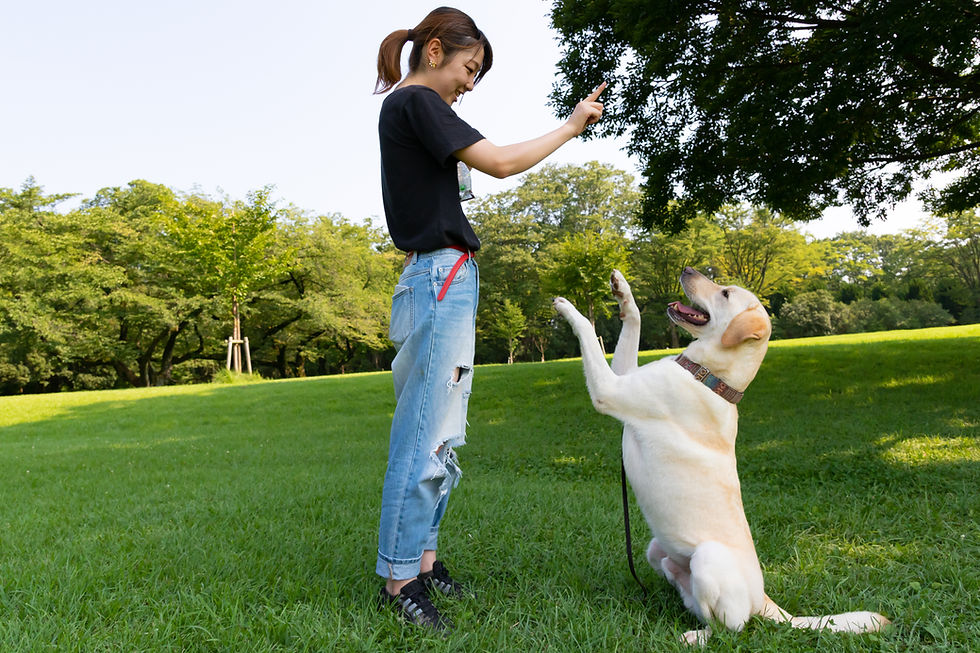What tools do I need for dog training at home?
- Subhodip Unitel
- Sep 25, 2024
- 4 min read
When embarking on your journey with dog training in North London, having the right tools is essential. Whether you're a seasoned dog owner or just starting with puppy training, the right equipment makes training more effective and enjoyable. This guide will help you understand the necessary tools for successful training sessions at home.

1. Basic Training Supplies
To start, gather some basic training supplies. These items lay the foundation for effective dog training:
Leashes and Collars
A sturdy leash and collar are vital for control during training. Choose a collar that fits well and a leash that is comfortable for your hand. A standard six-foot leash works best for most training scenarios. Avoid retractable leashes as they can hinder your ability to control your dog effectively.
Treats for Motivation
Positive reinforcement is crucial in dog training. Use small, tasty treats as rewards. Keep them handy during training sessions to motivate your dog. Make sure the treats are small enough for quick consumption, allowing your dog to focus on the training rather than chewing.
2. Training Clickers
A clicker is a simple but effective tool in training. It helps mark desired behaviours immediately. When your dog performs a command correctly, click the device and offer a treat. This creates a clear association between the behaviour and the reward. Many North London dog trainers recommend clicker training for its effectiveness.
3. Training Pads and Crates
For puppy training, training pads can be very helpful. They provide a designated area for your puppy to relieve themselves indoors, especially useful during bad weather. Over time, you can transition your puppy to go outside.
A crate also plays a vital role in training. It serves as a safe space for your dog and helps with house training. Dogs naturally avoid soiling their sleeping area, making a crate an effective tool for encouraging good habits.
4. Toys for Engagement
Training isn’t just about commands; it’s also about keeping your dog engaged. Use toys to stimulate your dog's mind. Interactive toys, such as puzzle feeders, can help challenge your dog while providing a reward for their efforts.
Fetch Toys
Toys for fetch not only promote physical exercise but also reinforce training commands like "come" and "drop it." Make sure to choose safe, durable toys that are appropriate for your dog's size.
5. Training Books and Online Resources
Consider investing in books or online courses that focus on dog training. These resources often include valuable tips and techniques from leading dog trainers. Look for content that aligns with your training goals, whether that’s obedience training, socialisation, or behaviour modification.
Video Tutorials
In addition to books, video tutorials can be incredibly beneficial. Many North London dog trainers share their techniques online. Watching these can provide visual guidance on how to execute training exercises effectively.
6. Training Aids for Specific Behaviours
Sometimes, dogs exhibit specific behavioural issues that require additional tools. Here are a few aids that can help:
Head Halters
If your dog pulls on the leash, consider a head halter. It gently guides your dog’s head, making it easier to control their movements. This tool is beneficial for larger breeds or strong pullers.
Bark Collars
For excessive barking, some owners find success with bark collars. These devices can deter barking through gentle vibrations or sounds. However, consult with a leading dog trainer and behaviourist before using them to ensure they’re appropriate for your dog.
7. Safety Equipment
Safety should always come first. Ensure you have the following items:
First Aid Kit
A pet-specific first aid kit is crucial. This should include bandages, antiseptic wipes, and other necessary supplies to handle minor injuries. Being prepared can prevent further complications during training activities.
Identification Tags
Make sure your dog wears an ID tag with your contact information. This is especially important during outdoor training sessions. Should your dog wander off, it increases the chances of being reunited quickly.
8. Creating a Training Space
Setting up a designated training area at home can enhance focus during sessions. Here’s how to create an effective space:
Quiet Environment
Choose a quiet space free from distractions. This will help your dog focus on you and the tasks at hand. As your dog progresses, gradually introduce distractions to prepare them for real-world situations.
Consistent Setup
Keep your training area consistent. Use the same location, equipment, and treats during each session. This helps your dog associate that space with learning and reinforces good behaviours.
9. Setting Goals for Training Sessions
Before you start, set clear goals for each session. Decide what behaviours you want to focus on, whether it’s sit, stay, or come. Having a plan keeps your training organised and purposeful.
Short, Frequent Sessions
Aim for short sessions lasting 5 to 15 minutes. Dogs have short attention spans, so frequent, focused training is more effective than longer sessions. As your dog becomes more accustomed to training, you can gradually extend the duration.
10. Consistency is Key
Consistency in training is vital for success. Use the same commands and rewards each time. Ensure that everyone in the household follows the same rules to avoid confusing your dog. This consistency helps reinforce the behaviours you want to encourage.
Conclusion
In conclusion, the right tools are essential for successful dog training in North London. With items like leashes, treats, clickers, and training pads, you can create an effective training environment at home. Don’t forget to utilise resources from leading dog trainers to enhance your learning experience. With Doggle by your side, you’ll have everything you need to train your furry friend effectively and joyfully.



Comments